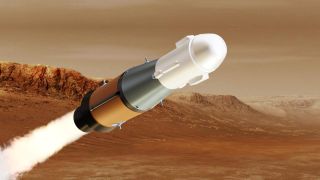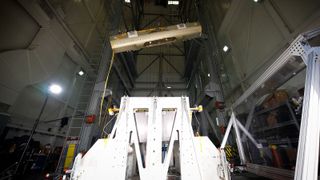Work is progressing on a key part of NASA’s Mars sample return plans.
The Mars Ascent Vehicle (MAV) is a small, lightweight, two-stage, solid-propellant rocket with a big mission: to blast samples of rock, sediment and atmosphere March in the early 2030s, during the first-ever rocket launch from the surface of another planet.
The MAV, which is being developed by Lockheed Martin Space of Littleton, Colorado, will be paired with NASA’s Sample Retrieval Lander (SRL), another important component of the sample return campaign. The two-in-one spacecraft – MAV and SRL – will land near or in Jezero Crater, the location where NASA Rover of Perseverance is already collecting samples from Mars. A second lander, carrying a European Space Agency (ESA) fetch rover, will also land in the same area.
Related: Mars samples from the Perseverance rover won’t make it to Earth again until 2033 at best
The recovery rover will bring the Perseverance samples to MAV. The rocket will launch into Mars orbit, where ESA’s Earth Return Orbiter (ERO) will grab its container full of samples. The ERO will then transport the samples to Earth, ejecting them via an Earth Entry System (EES) for a high-speed, parachute-less landing in the Utah desert in 2033, if all goes as planned.
This sample return capsule, also designed by Lockheed Martin, is made of a lightweight composite structure, wrapped in special thermal protection material provided by NASA’s Ames Research Center in Silicon Valley, California.
Humanity has never returned pristine samples from Mars before, and the team trying to get there faces significant challenges, said Steve Sides, Lockheed Martin’s senior program manager for the Mars Ascent Vehicle. Integrated System (MAVIS) based in Huntsville, Alabama.
Aim it, aim and shoot
The MAV is less than 10 feet tall and 1.5 feet in diameter (3 by 0.5 meters), Sides told Space.com. “It’s relatively small rockethe said, “so aim, aim and shoot. »
Lockheed Martin Space provides NASA with several MAV test units and a flight unit. Work under the contract includes the design, development, testing and evaluation of the integrated MAV system as well as the design and development of the rocket’s ground support equipment.
The MAVIS contract at cost plus fixed costs has a potential value of $194 million and will span six years. The clock is turning. The SRL-MAV duo is currently set to launch in 2028 from NASA’s Kennedy Space Center in Florida, kicking off the long journey to the red planet.
“The objective is to land there at the start of the year and take off before [Martian] winter hits,” Sides explained.
Related: NASA’s Perseverance Mars rover retrieves 8th rock sample from Red Planet
Loft and light
A new aspect of the MAV design is the use of a gas generation concept – a vertically ejected controlled tip release, or VECTOR for short. It’s a loft-and-light technique led by NASA engineers Jet Propulsion Laboratory in Southern California, which builds the SRL.
The MAV will carry approximately 30 sample tubes, which will be loaded from the recovery rover into the rocket by the SRL’s robotic arm. The MAV will then launch into thin Martian air, about 18 feet (5.5 m) above the lander, which also serves as a launch pad. At this point, the rocket’s first-stage engine will ignite, Sides said.
“Launching a rocket and bringing it to light has been done before, but never on Mars,” Sides said. The VECTOR approach minimizes backfire and interference with the SRL, he explained.
Once ignited, the rocket heads into Mars orbit. “At the end of the day, the MAV is on the order of about 4,000 meters per second. [8,950 mph, or 14,400 kph] to reach Mars’ escape velocity,” Sides said.
After the first stage separates, the second stage spin motors activate to stabilize the still flaming stage, then slow down. “We’re going to ride for 10-15 days,” Sides said. During this time, a beacon on the upper floor will broadcast its location for rendezvous and capture by a system on board the ERO.
An early and concrete step
“We’ve never launched a rocket from Mars, so there’s a lot of technology involved here,” Sides said. “But we’re also going to get a lot of scientific data from these Mars samples.”
Indeed, returning samples from Mars has been on NASA’s to-do list for decades. “It’s tough, but the technology and the time to do it is good. We just have to go for it,” Sides said. “I wouldn’t put it in the easy category…but I wouldn’t put it in the ‘unobtainium’ category,” he added. “We have the capacity now.”
Thomas Zurbuchen, associate administrator for science at NASA Headquarters in Washington, said in an agency statement (opens in a new tab) in February that committing to the MAV represents “an early and concrete step in refining the details of this ambitious project not only to land on Mars, but to take off from it”.
Parts
These pieces of Mars will land with a thud in the Utah desert.
To test the Mars Sample Return EES, engineers conducted a series of drop tests at the Utah Test and Training Range, the lakebed site where the samples will land.
In recent testing, a manufacturing demonstration unit (MDU) of a potential design for the EES aeroshell was fell from an altitude of 1,200 feet (opens in a new tab) (365 m), giving him time to reach the planned landing speed.
“The MDU was very stable during the descent – it didn’t wobble much and landed successfully, in that there was no structural damage and it survived the impact as expected” said NASA’s Jim Corliss, a Mars sample return SEA chief. engineer, said in an agency statement in April (opens in a new tab).
“We are nearing the end of the concept phase of this Mars Sample Return mission, and the pieces are coming together to bring home the first samples from another planet,” Zurbuchen said in the February release. “Once on Earth, they can be studied by advanced tools too complex to be transported in space.”
Leonard David is the author of the book “Moon Rush: The New Space Race”, published by National Geographic in May 2019. A longtime author for Space.com, David has been reporting on the space industry for more than five decades. Follow us on twitter (opens in a new tab) Or on Facebook (opens in a new tab).
 Jenam 2011
Jenam 2011

